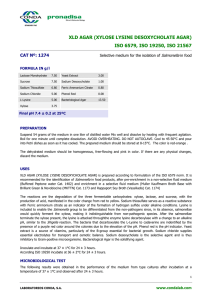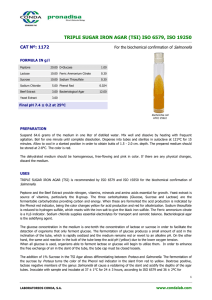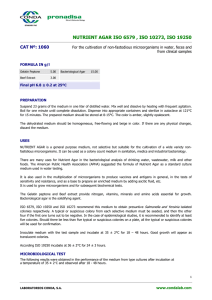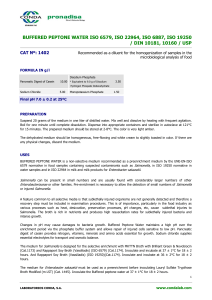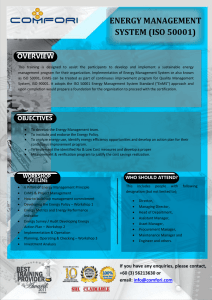LYSINE DECARBOXYLASE MEDIUM ISO 6579, ISO 10273, ISO 19250 Salmonella
advertisement
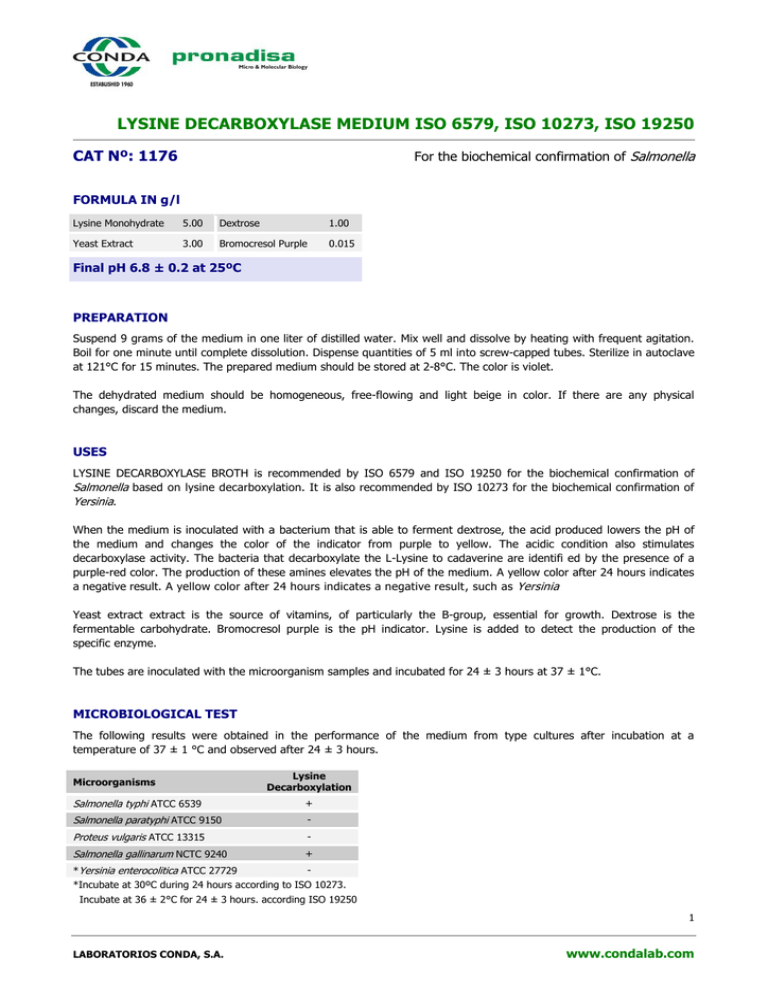
LYSINE DECARBOXYLASE MEDIUM ISO 6579, ISO 10273, ISO 19250 CAT Nº: 1176 For the biochemical confirmation of Salmonella FORMULA IN g/l Lysine Monohydrate 5.00 Dextrose 1.00 Yeast Extract 3.00 Bromocresol Purple 0.015 Final pH 6.8 ± 0.2 at 25ºC PREPARATION Suspend 9 grams of the medium in one liter of distilled water. Mix well and dissolve by heating with frequent agitation. Boil for one minute until complete dissolution. Dispense quantities of 5 ml into screw-capped tubes. Sterilize in autoclave at 121°C for 15 minutes. The prepared medium should be stored at 2-8°C. The color is violet. The dehydrated medium should be homogeneous, free-flowing and light beige in color. If there are any physical changes, discard the medium. USES LYSINE DECARBOXYLASE BROTH is recommended by ISO 6579 and ISO 19250 for the biochemical confirmation of Salmonella based on lysine decarboxylation. It is also recommended by ISO 10273 for the biochemical confirmation of Yersinia. When the medium is inoculated with a bacterium that is able to ferment dextrose, the acid produced lowers the pH of the medium and changes the color of the indicator from purple to yellow. The acidic condition also stimulates decarboxylase activity. The bacteria that decarboxylate the L-Lysine to cadaverine are identifi ed by the presence of a purple-red color. The production of these amines elevates the pH of the medium. A yellow color after 24 hours indicates a negative result. A yellow color after 24 hours indicates a negative result, such as Yersinia Yeast extract extract is the source of vitamins, of particularly the B-group, essential for growth. Dextrose is the fermentable carbohydrate. Bromocresol purple is the pH indicator. Lysine is added to detect the production of the specific enzyme. The tubes are inoculated with the microorganism samples and incubated for 24 ± 3 hours at 37 ± 1°C. MICROBIOLOGICAL TEST The following results were obtained in the performance of the medium from type cultures after incubation at a temperature of 37 ± 1 °C and observed after 24 ± 3 hours. Microorganisms Lysine Decarboxylation Salmonella typhi ATCC 6539 + Salmonella paratyphi ATCC 9150 - Proteus vulgaris ATCC 13315 - Salmonella gallinarum NCTC 9240 + *Yersinia enterocolitica ATCC 27729 *Incubate at 30ºC during 24 hours according to ISO 10273. Incubate at 36 ± 2°C for 24 ± 3 hours. according ISO 19250 1 LABORATORIOS CONDA, S.A. www.condalab.com BIBLIOGRAPHY ISO 6579 Microbiology of food and animal feeding stuffs – Horizontal method for the detection of Salmonella spp ISO 10273: Microbiology of food and animal feeding stuffs – Horizontal method for the detection of presuntive pathogenic Yersinia enterocolitica. Falkow A. S. Clin. Path. 28:598, 1958. Ewing Davis and Deaves, Studies in the Serratia Group. U.S. Dept. H.E.W.C.D.C. Atlanta, 1972. Edwards and Ewing. Identification of Enterobacteriaceae, Burgess Publ. Co. Minneapolis, Minn., 1961. ISO 19250 water quality-detection of Salmonella spp ISO STORAGE 25ºC Once opened keep powdered medium closed to avoid hydration. 2ºC 2 LABORATORIOS CONDA, S.A. www.condalab.com

